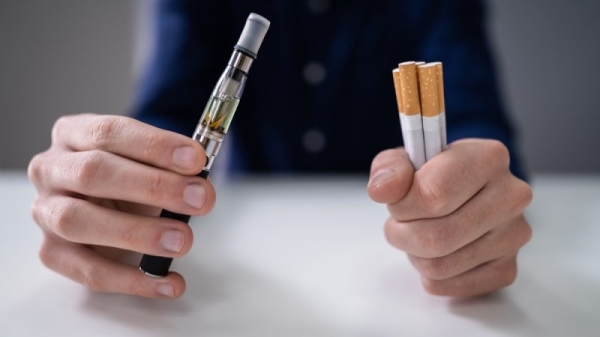Novel products: The unconvinced smokers and vulnerable youth

The use of novel tobacco and nicotine products should only be recommended to heavy smokers who tried everything else and still smoke traditional cigarettes, Professor Andrzej Fal told EURACTIV.com in an interview.
“If you are a smoker and nothing has convinced you yet to quit […], then harm reduction products should be the ultima ratio [last resort]”, Dr Fal said.
The market of novel tobacco and nicotine products – such as electronic cigarettes, heated tobacco and nicotine pouches – has skyrocketed in the last years with an increasing number of consumers switching.
Referring to studies, novel tobacco product advocates claim that they are significantly less harmful than traditional cigarettes.
On the other hand, EU policymakers and the World Health Organisation (WHO) remains firmly negative amid a lack of knowledge regarding their long-term health effects.
EU member states have implemented several measures to decrease smoking, such as excise taxes, smoking bans in public places or advertising bans.
For Dr Fal, if a smoker is not affected by policy measures or the help of a doctor, a nicotine replacement therapy or psychotherapy did not work out, only then should they eye these novel products.
“The final thing that we can do is the harm reduction because, well, the disease [smoking] you already have will run less harmful […] will be less severe to you”, he said.

Stakeholders clash on need for EU plan on tobacco harm reduction
Public health stakeholders are divided over whether the EU needs a strategy to reduce harm from smoking, which according to the World Health Organisation (WHO) costs Europe nearly 700,000 deaths annually.
The Polish medical professor stressed, though, that no product in this new group is harmless or neutral for human health.
“That’s why we introduced the term harm reduction. We’re not saying that any of the products introduced are positive to your health or neutral to your health. We’re not saying that because this wouldn’t be true,” he said.
The Polish expert explained that if governments want to achieve a smoke-free society, they should start from kindergartens.
“The education has to be started at those who do not smoke yet who never have heard of a cigarette,” he said.
“People smoke, and they literally will keep smoking until we start a very serious, primordial prevention in public health which starts with the basic education at the very at least stage from a kindergarten,” he added.
The taxation issue
For centre-right EU lawmaker Aldo Patriciello (Forza Italia/EPP), new nicotine and tobacco products are an essential tool to enable smokers to quit smoking.
“This is something that was already acknowledged by the European Parliament in its report on Europe’s Beating Cancer Plan,” he told EURACTIV Italy.
He said nicotine is addictive, but it is not what causes cancer.
“So, any regulation on the products must recognise the harm reduction role new nicotine products can have and push smokers who have failed to quit smoking over the years, to try this alternative”, he said.
Currently, there is no EU-wide excise framework as there is for traditional tobacco products. The situation in the EU single market is quite fragmented, as member states tax e-liquids and heated tobacco products at different rates.
The European Commission will soon publish its proposal for the Tobacco Excise Directive (TED), with many projecting an EU-wide excise tax on novel tobacco products.
Some argue that heavy taxation would result in smokers not switching to novel products. Others insist that such a move is needed, considering that harm is still harm, and therefore, taxation is a tool to prevent people from consuming these products at all, particularly young people.
Riccardo Polosa, Professor of Internal Medicine at the University of Catania, said it is a “serious mistake” to put combusted tobacco and novel products in the same box.
“It leads to a very specific communication pathway, which does not differentiate the harm caused by cigarettes from that of alternative nicotine delivery products, which are now recognised to be 95% less harmful than combustion products,” he told EURACTIV Italy.
Polosa, who is also founder of the CoEHAR Research Centre for Smoking Harm Reduction, explained that this results in misinformation.
The Italian professor cited as an example data from the French e-cigarette consumer association, suggesting that in 2022 almost eight out of ten French people did not know that vaping is less dangerous than combustion smoking and that they “mistakenly believe that nicotine is carcinogenic”.

EU tobacco taxation: The fine line between killing smoking and illicit trade
The European Union’s plans to further increase tobacco taxation and reduce already declining smoking rates across the bloc have pleased public health advocates. At the same time, however, the industry warns that tax revenues may be disrupted by the rise of illicit markets that flourish when taxes are high.
Protecting young people
Another sensitive element of the novel tobacco products’ rise is their impact on young people. Many have expressed their fear that unless strict measures are in place, a new generation of nicotine addicts – mainly youngsters – may emerge.
“I am a strong supporter of a harm reduction policy, but in no way I will support any harm reduction idea be at the same time available to those who do not need harm reduction because they are not using the old very harmful products,” Dr Fal said.
The Polish professor warned that currently, there are more young e-cigarette users than general cigarette smokers.
“We really produced a new group of people that are dependent on something less harmful but still harmful,” he said.
“The regulations for the harm reduction products should be as tough as they are for the regular product,” Dr Fal noted.
A recent study in the UK raised eyebrows suggesting that putting vapes in plain packaging “reduces their appeal to children”.
Notably, the study found that removing bright colours, pictures and fancy lettering from packaging made youngsters less likely to be attracted to vaping but did not deter adults who wanted to use vapes to quit cigarettes.
MEP Patriciello agrees that young people should be protected but emphasises that the measures should not create a barrier for adults who want to quit smoking.
“Flavours are vital for adults who are twice more likely to quit with flavoured e-cigarettes than with non-flavours products,” he said, adding that a 2020 Eurobarometer survey found that 64% of vapers used flavours other than the traditional tobacco flavour.



